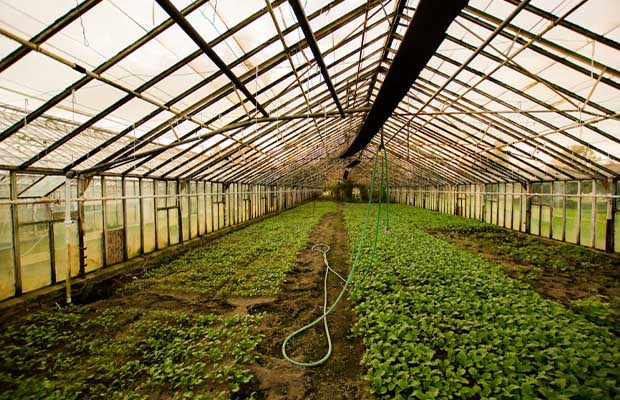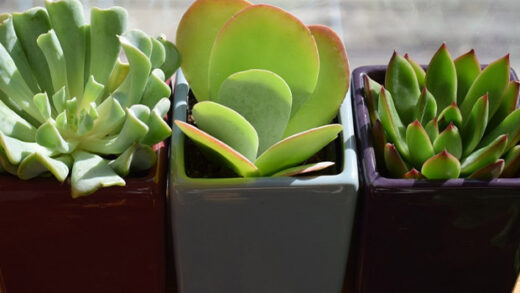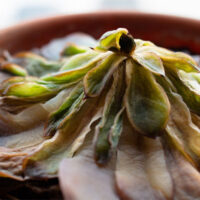A greenhouse is also called a forcing structure, that is, an artificial environment in which plants are “forced” to grow, despite the harsh outside climate. It can aid in boosting fruit production and plant growth and even enable you to grow plants that wouldn’t typically thrive in your climate.
So, how does a greenhouse work? The sun’s light is let into the building through glass or plastic sheeting where it is absorbed by the plants and turned into heat. The greenhouse stays warm as a result of the heat energy that the plants release being trapped by the glass.
The fundamental ideas behind greenhouse operations are fortunately simple to comprehend. Your inquiries about the various kinds of greenhouses and their operation will be addressed in this guide.
Table of Contents
What Is A Greenhouse?
A greenhouse is a building with walls and a roof made of a transparent material, typically glass. A greenhouse uses sunlight to create a climate-controlled environment for growing plants.
The technology of greenhouses is not new. In the year 30 CE, they were in use by the Roman Empire. because Cucurbits, a melon that resembles a cucumber, were what Emperor Tiberius preferred to eat all year long.
Related Reading:
How Does A Greenhouse Work?
The process of light energy being converted to heat energy is the simplest way to explain what takes place in a greenhouse.
The greenhouse is heated when objects inside the greenhouse absorb solar energy and convert it to heat.
It is crucial to remember that objects of various colors will react to sunlight in various ways.
Darker objects will absorb light and warm up as a result. Lighter-colored objects reflect light rather than absorbing as much of the sun’s rays.
Heat is not easily expelled from the greenhouse for a few different reasons.
The first reason the heat from the sun does not leave the greenhouse is that after an object absorbs the light energy it will release the heat energy very gradually. Consider a dark-colored object that is exposed to the sun. It will heat up very quickly, but it will take a long time for it to cool down.
The second reason the heat does not leave is that heat energy does not pass through glass and plastic sheeting as well as light energy. What happens to the heat energy as the heated object cools down? The air is filled with heat energy. Warm air rises, but because heat cannot travel as far through materials like glass or plastic as it can through other media like light, it becomes effectively trapped inside the greenhouse when it reaches the roof.

Benefits Of Getting A Greenhouse
I think a greenhouse should be your ultimate objective if you have even a small sunny area in your yard. More gardening space, complete climate control, and the best (and most cost-free) light source available are all provided by greenhouses.
When would you need a greenhouse? when your enthusiasm and plants have overrun your home. A significant portion of your family’s vegetable needs may also be met by you now that you’re serious about it.
View the cost of a greenhouse as an investment in the health and happiness of your family. Providing a sizable amount of nutritious food in a safe environment is more than just a pastime; it might even be necessary for survival!
How Does Greenhouse Trap Heat And Light?
For survival and growth, plants require light, warm temperatures, air, water, and nutrients. For each of these necessities, different plants have different needs. The first two requirements are fulfilled by a greenhouse, leaving you to take care of the remaining three.
Step 1: Light Comes In
Greenhouses require a way for light to enter if they are to provide light. Because of this, greenhouses are typically made of transparent materials like glass or clear plastic. The plants inside get the most sunlight possible because of this.
Step 2: Heat Is Absorbed
When light enters the greenhouse through the glass walls, it is absorbed by the plants, the ground, and anything else present, turning it into infrared energy (also known as heat). A surface’s ability to absorb energy and convert it to heat increases with its level of darkness. Because of this, black pavement becomes extremely hot during the summer. It is absorbing a lot of heat.
Step 3: Heat Gets Trapped
After being transformed from light energy into infrared energy (heat), infrared energy takes on a different “shape” than light energy, which scientists refer to as wavelength. Heat can’t easily escape through the greenhouse’s glass walls because of the change in wavelength. It was therefore simple to enter, but more difficult to exit.
Step 4: Warming The Greenhouse
Because a greenhouse is comparatively airtight and the heated air inside is kept inside, the temperature of the entire structure rises. The trapped heat warms the air inside the greenhouse. You have undoubtedly noticed the same effect when getting into a car after it has been parked in the sun for a few hours. Warm weather prevails.
Step 5: Staying Warm
In fact, on a hot, sunny day, you may need to ventilate the greenhouse the entire time to prevent the plants from literally cooking inside. With enough sunlight, the temperature inside a greenhouse can rise much higher than the outside temperature. On cloudy days, the greenhouse will heat up more slowly, if at all, due to the reduced amount of sunlight. Due to this, greenhouses work best in regions with lots of sunlight.
Step 6: Promoting Photosynthesis
With so much light and warmth, plants have easy access to the sunlight and temperatures they need to develop. This is due to the fact that they have favorable conditions for photosynthesis to take place. Carbon dioxide from the atmosphere and solar energy are combined during photosynthesis to create simple sugars, which the plant uses as food. The sun is what a plant uses, just like you might eat a cheeseburger to grow big and strong. Plants generally require six hours of sunlight per day, though this varies depending on the type of plant; positioning your greenhouse where it will receive full sun all day will ensure that the plants inside receive enough light.
What If There’s No Sun?
The majority of a greenhouse’s exterior is made of glass or plastic, which is great for letting in the most light but is a poor insulator (it doesn’t hold heat well). This indicates that the heat energy eventually passes through it to escape to the outside environment. This is unimportant as long as the sun is shining because light energy enters the atmosphere more quickly than heat can escape. But at night, when all that heat energy quickly dissipates, your plants will be at the mercy of the cooler nighttime temperatures. You must either store excess heat during the day or use a man-made heat source at night in order to protect your delicate plants.
Storing Heat During The Day
The property known as thermal mass states that different materials require different amounts of energy to warm up (bricks require more time to warm up than dirt or gravel). The amount of energy required to raise the temperature of a material depends on its density, or how tightly packed it is. High-density materials can therefore hold a lot of heat. High-density material examples include:
- Stone
- Brick
- Water
Flooring Matters
Your greenhouse will take longer to warm up during the day if you add a brick floor, but at night, all that extra heat energy will be gradually released into the air inside the greenhouse. Even after the sun sets, this will keep your plants warm and cozy.
Dual Purpose Features
By keeping sizable fish tanks inside their greenhouses, some enterprising greenhouse owners multitask. The fish grow faster and are more productive because of the additional warmth, the water in the tank has a lot of thermal mass to store heat, and the waste that is removed when cleaning the fish tank makes an excellent fertilizer for the greenhouse plants.
Adding Artificial Heat
If increasing the greenhouse’s thermal mass is not an option, you can always install an artificial heat source, such as a space heater. A heat source connected to a thermostat would be ideal because it would automatically maintain the interior temperature within the desired range. Many different types of artificial heaters made specifically for use in greenhouses are available in greenhouse supply stores.
Effectiveness Of Greenhouse
Plants can be grown in greenhouses year-round, including in the summer. These clever inventions provide food and warmth for plants by capturing light and converting it to heat. Water and other materials, such as bricks and stone, can help to keep the heat in on chilly nights. You might also think about incorporating an outside heating source.
Related Reading: How To Keep A Greenhouse Warm In The Winter?
Take Away
Your plants will still require your assistance to meet their other needs, despite greenhouses being very effective at their two main functions—providing light and warmth.
In fact, plants frequently use up nutrients and carbon dioxide more quickly in high light and heat environments, necessitating frequent fertilization and periodic greenhouse venting to provide fresh air.
Maintaining the greenhouse’s temperature, light, humidity, and nutrition levels within the ranges preferred by the plants you want to grow is your main objective. If you have any further questions, please leave a comment below.
Also Read:

















